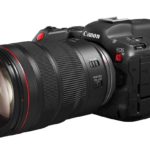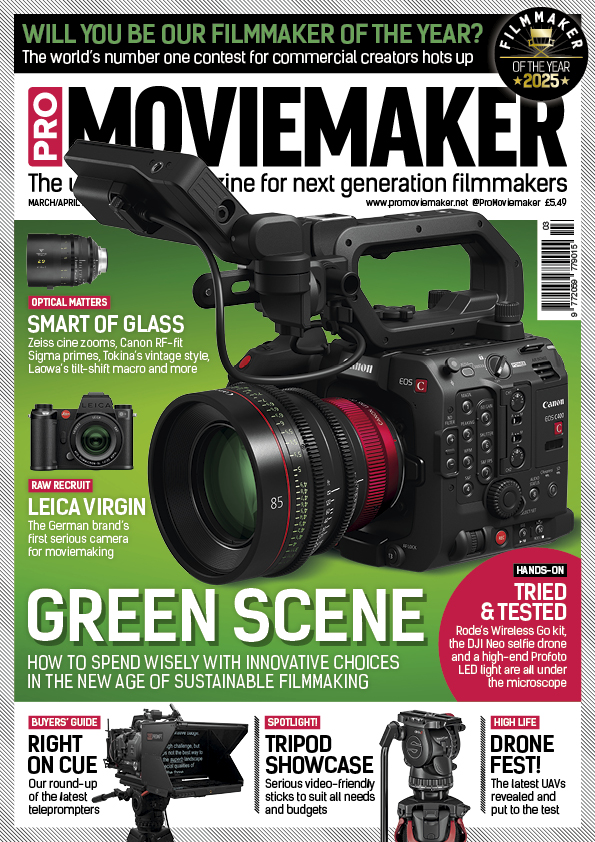
Pro Pick: Focus on the AF Red
Posted on Jan 14, 2022 by Alex Fice
The award-winning Red Komodo has 6K Raw recording, a global shutter and, finally, phase detection autofocus
Words Adam Duckworth
Red really has got it very right with its affordable Komodo 6K. We knew that from when we first got our hands on an early version with a prototype firmware – it was a stunner. And now it has later firmware that allows phase detection autofocus with Canon RF lenses, or EF lenses with an adapter, so it’s only got better.
It was an obvious winner in the cinema category of this year’s Pro Moviemaker Gear of the Year Awards, as readers voted for it in huge numbers. It’s a smaller and more attainable way into the Red ecosystem, but doesn’t compromise on quality. It uses the legendary R3D Redcode Raw workflow, to fit in seamlessly with more expensive Red camera production pipelines. And, perhaps best of all, it has zero rolling shutter issues that blight every other camera in its price range. You get no wobbly lines in footage from the Komodo, as it has a global shutter, so fast whip pans are not a problem.
Compared to other, far pricier Reds in the older DSMC2 range, it actually has more technology. The earlier Reds focus on image quality and a tough, modular build above all else. The Komodo was the first of the next-generation cameras from the Californian tech wizards to use the very latest spec, and is now joined by the full-frame V-Raptor 8K. That costs significantly more than the Super 35 sensor Komodo, which can be had for £5940/$5995. To give it some context, that’s cheaper than the flagship Sony A1 mirrorless camera, and you certainly don’t get a global shutter and internal Raw or ProRes recording in that.
What current mirrorless and full-frame cinema cameras from Sony and Canon do offer is a proper phase detection autofocus system, with advanced features like subject tracking and eye detection. The Komodo is now entering this arena in a bid to make it a more usable, all-round camera – rather than just for cinema.
By using the new Canon RF-style lens mount, the Red does have phase detection AF, but when selecting it in the menu, it’s still labelled as a ‘Beta’ firmware. It works, but definitely lacks all the bells and whistles of the latest Sony and Canon systems. Whether this will come in a future firmware upgrade is unknown. It’s best to consider what the camera offers right now, rather than what might be coming around the corner.
For AF, you have to go via the menu, rather than some external button. While this would lead to a frankly bewildering number of options on some cameras, the Red has just the basics. This might be exactly what you need, if you are dipping a toe into the water of autofocus for video. Or, you might quickly find it limiting. AF speed can’t be set, it can be ‘sticky’ before hunting for another subject, and there is no face detection or eye detection technology.
The AF mode is either full-time Continuous or Single shot, where it nails focus – then stops focusing. You can adjust the size of the AF point, with the smallest a bit too tiny to use with your fingers on the touchscreen. Then, set the position of the AF point in the menu.
The real beauty is using a finger on the touchscreen to move the AF point around; you can do nice focus pulls, too. And the AF doesn’t just snap on, but slows down as it nears the focus point, to make it feel more like a manual focus puller is doing the work.
In real-world use, it was speedy and locked on to a subject well. But occasionally it would miss and hunt around a bit, or stay locked on while you jabbed at the screen in a bid to make it focus somewhere else.
If you are used to Canon Dual Pixel AF, or Sony’s hybrid systems, you will be a bit disappointed. It’s not as precise, nor does it have all the desirable functions.
But if you are coming from a manual-focus cinema camera, or a machine with old-school contrast detect AF, then it’s a revelation. Although it worked well in a run-and-gun documentary style of shooting, it feels designed for the cinematic aspect, where if the AF doesn’t nail it first time, you can reshoot. It’s also very simple, to avoid putting off first-time AF converts – probably a good thing, considering the intended audience. Firmware upgrades since we tested the original Komodo have also added anamorphic de-squeeze options, which speaks volumes about who this camera is for.
That someone wants incredible colour, the best codec choices and amazing image quality, as easily as possible. The sensor has lots of dynamic range, and ISO goes from 250 to 12,800, with a sweet spot around 800. Sensitivity is good when light levels drop.
The Komodo records compressed Raw in low-, medium- or high-quality levels, and all debayering is done in post. This means it’s easier to capture all that data, and allows the recording of its R3D Raw files to a CFast card. And the Komodo can record in various ProRes 422 settings for a faster workflow. You can switch between Raw and ProRes, but the camera has to reboot – and this can take up to 30 seconds each time.
Opening Raw files is possible with standalone software, like Red’s free Redcine-X Pro, to transcode them into something editable. But Adobe Premiere Pro and Blackmagic DaVinci Resolve will read them as native files.
Using Raw files means you can change the white balance, ISO, highlight and shadows, highlight roll-off, sharpening – and add noise reduction. Then, export from Redcine-X Pro into whatever format you like for editing, and original Raw files are still kept intact. The camera supports custom LUTs, and you can upload your own, with a huge number of free custom LUTs on the Red website – or even get creative yourself.
Editing 6K files does stress your editing computer, but put in the effort and you are rewarded with natural skin tones, lots of highlight and shadow detail, and simply wonderful colours.
The camera records from the whole size of its Super 35 sensor in 6K. Then, going down to 5K, 4K or 2K, is simply a crop of the sensor – so the angle of view changes, as well as the maximum frame rate.
Compared to a full-frame 35mm sensor, shooting the Red Komodo in 6K gives an equivalent 1.34x crop and a maximum frame rate of 40fps. In 5K, it’s a 1.61x crop and 50fps, while 4K is 2.01x and 60fps. Shoot in 2K and it’s a 4.02x crop against full-frame, but this allows you to record up to 120fps.
Control comes via the built-in, touch-screen colour display, which is 73.7×73.7mm/2.9×2.9in, and allows access to menus, as well as a small live preview. The screen has a histogram display, false colours, and traffic light system to show whether exposure is right.
On our limited-edition white Komodo ST camera – often called the Stormtrooper, although Mr Lucas doesn’t like that – we used an external Atomos Shinobi SDI monitor, as it’s small and light, with a huge range of tools to get everything correct.
Camera settings must still be inputted on the small touchscreen, which uses a Red UI that is easy to understand and use. The camera comes with built-in Wi-Fi, so you can link it up to a smart device and control from the dedicated app. Or, maybe use your iPad as a director’s monitor.
With the Red, you don’t get many of the regular cinema camera features, like built-in ND filters and XLR audio inputs. There is a standard audio-in jack for plugging in a DSLR-style mic, and we used a variable ND on the lens to control exposure. But the Red is modular, so you attach what is needed and nothing more.
At the rear of the camera is a battery mounting plate for a pair of Canon BP batteries, which are hot-swappable. And at the bottom is the Komodo Expander Module, which gives more options for mounting, as well as Genlock, BNC, timecode and four-pin control sockets. We also used the Komodo Link Adaptor to give USB-C control – ideal for connecting to a smart device.
The base Red Komodo really is a base model; batteries, monitor and rig must all be added. But that means it can be stripped down on a gimbal, rigged up for handheld use, or fully dressed with external ancillaries as a real cinema camera. Whatever you use it for, the results are incredible.
The Verdict
If you have always wanted the kudos of owning a current-model Red, then your wait is over. Image quality is amazing, colours are stunning, there are zero rolling shutter issues and it can be rigged up like a cinema camera – or stripped back. And the phase detection AF makes it usable for run-and-gun documentary work.
It might not have XLR audio inputs or built-in ND filters, but there are workarounds for this, such as lens mounts that have NDs built in. You can even just use variable NDs on the front of the lens, along with an XLR adapter. The compact form only means it’s flexible.
This is a fantastic camera at a great price, allowing you full membership of the Red club.
Features: 9
A global shutter, phase detection AF and Raw recording
Performance: 10
Stunning 6K Raw files, wonderful colour
Handling: 8
Compact body, but it does require bolt-on accessories
Value for money: 9
Not cheap, but a bargain for what you get
Overall rating: 9/10
It’s the cinema camera you always promised yourself
Pros: Global shutter, image quality, AF
Cons: No XLR audio, built-in ND filters or IBIS
Read the full article here.
For more information, visit Red’s website.










